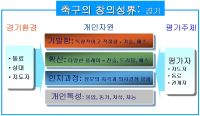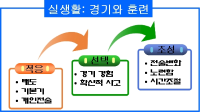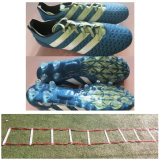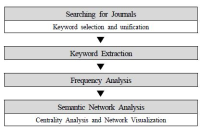
The purpose of this study was to explore a framework of understanding football performance. Researcher review was conducted to organize perspectives for football performance and drew implications as well as drift of football performance based on intelligence approach. Discussions for intelligence had been proceeded in concepts of learning ability, multiple intelligence, successful intelligence, and moral intelligence. Discussions of football performance approaches fitness, skill, and strategies in traditional intelligence aspects. The multiple intelligence perception discusses perspective, mentality, body, and analysis. The successful intelligence perspective deals with creativity, practical intelligence, and football talents. However, specific discussions for moral intelligence have not been progressed yet. FIFA’s social responsibility project and UEFA’s RESPECT campaign reflect that the discussions of football performance develops in a way of the moral intelligence. In European football, issues regarding value, such as RESPECT and against Racism, are currently emerging. Considering the change in the European football, the global football leagues will share the issues related to value in the near future. Given the fact that discussion for intelligence had been proceeded learning ability, multiple intelligence, successful intelligence, and moral intelligence, the moral intelligence will be a main concern in the further football performance discussion. The moral intelligence will be incorporated into football performance evaluations soon. Furthermore, teams and players will strive to place efforts in order for pursuing value and reputation as factors of performance.







Purpose This study was to investigate the effect of various motor leaning techniques which were applied on the youth soccer training program. Methods 12 elementary soccer players and the director of R youth soccer team have participated in the study. The expertise level of youth soccer team were ranged from beginner to advance. To investigate the effect of new soccer training program we adopted a methodology of action research. We first analyzed the problems of original youth soccer program and reconstructed the training program considering of individualized characteristics. The 3 main problems of original soccer program (1. feedback provisions 2. difficulty of task level 3. time distribution of training) have been reconstructed by four motor learning experts. For the data analysis, several qualitative analyze techniques were conducted to observe player’s improvements. Results First, participants had a better understanding on proper motion of shooting and lifting skills from the guidance techniques. Second, utilizing the personal skills and team cohesion have been improved by the modified rules and space competition. Third, the ability of active problem solving have been improved from the self-learning environment. Forth, the player’s confidence level have been improved by eliminating performance outcome. Conclusions From the aspects of variety circumstances in sport education field, the comprehensive motor learning program should be developed and applied.

PURPOSE This study aims to analyze the competitive advantages of Japanese and South Korean national football teams using the value, rarity, imitability, and organization (VRIO) model. Based on the results, it proposes strategies for the development of South Korean football. METHODS The research methodology is a combination of literature review, case study, and semi-structured interviews with football experts. RESULTS The Japanese football system meets all criteria of the VRIO model through its systematic youth development system, data-driven strategies, and organizational linkage between clubs and the national team, which has led to consistent performance in international tournaments. In contrast, while South Korean football possesses excellent individual player resources, it fails to fully meet the criteria of the VRIO due to a regional imbalance in the youth system, insufficient use of data, and lack of cooperation between clubs and the national team. CONCLUSIONS The interview data indicate that strengthening the youth system, adopting a data-driven approach, and improving the collaborative structure between clubs and the national team are necessary components of the development of South Korean football. This study provides specific directions for the long-term and sustainable development of South Korean football by analyzing the strategic competitiveness of national football teams in other countries using the VRIO model.

This study was to analyze the hierarchical importance of successful intelligence in Football coaches and players. In order to explore the hierarchical importance of successful intelligence 24 football coaches(under AFC A course) and 20 Korea Football Association U15 Players were responded to analytic hierarchy process questionnaires. In the Analytic Hierarchy Process, football coaches and players completed the AHP Questionnaire with creative intelligence, analytical intelligence and practical intelligence. The hierarchical importance order of successful intelligence for coach and player were analytical intelligence, practical intelligence, and creative intelligence respectively. Evaluation of hierarchical importance of successful intelligence for coach is analytical intelligence(.542), practical intelligence(.278), creative intelligence(.181) in order. Evaluation of hierarchical importance of successful intelligence for coach was analytical intelligence(.684), practical intelligence(.161), creative intelligence(.155) in order. The hierarchical importance of successful intelligence for coach and player were similar each other. Analytical intelligence, was evaluated most important factor for coach and player in successful intelligence. Successful intelligence is important issue for sport performance. More consider needs to Successful intelligence for sport psychology researchers.






Purpose The purpose of this study was to investigate the lower extremity muscles activity during forward side step by soccer field ground types. Methods Fifteen elite high school soccer players participated in this study. Muscle activation patterns were recorded at 2000 Hz during forward side step task. Surface EMG of the tibialis anterior(TA), soleus(SOL), medial gastrocnemius(MG), lateral gastrocnemius(LG), peroneus brevis(PB) muscle was recorded, and the root mean square of the EMG was normalized, using a maximum voluntary isometric contraction(%MVIC). One-way repeated ANOVA was used for comparison among three soccer field ground types(natural grass, artificial turf, hard ground). Results Artificial turf displayed greater soleus and peroneus brevis activities compare to natural grass during forward side step task. Conclusions The relationship between increased soleus and peroneus brevis activation and greater incidence of injury in artificial turf versus natural grass requires further study. Soccer players routinely training on artificial turf for prolonged periods should be carefully monitored.


Purpose This study aims to explore the association between the awareness of naturalized players and the awareness of recruiting naturalized players for national players among sport fans. Methods Survey was conducted among 1,050 fans in professional sport, amateur sport, sport cafes at portal website among which 928 papers were used for final analysis. Collected data was processed by using SPSS 21.0 program. T-test, one-way ANOVA, correction analysis and multiple regression analysis were conducted to test hypothesis. Results Gender, age, household, and field income showed significant differences in the awareness of achievement among the awareness of naturalized players by fans. Age, school, and field revealed significant differences in the awareness of attitude. Age, school, household income, and field showed remarkable differences in the awareness of field and age and household income showed critical differences in the ascription awareness. Negative awareness showed that gender, age, school, and income were significantly different and the tolerable awareness showed that age, school, household income, and field revealed significantly different among the awareness of recruiting naturalized players for national players. Achievement, attitude, and ascription factors had positive impacts, while field factors had negative impacts in terms of the influence on negative awareness among the awareness recruiting foreign players for national players. In terms of the influence on the tolerable awareness, achievement, attitude, and field affected positively. Conclusions This study demonstrated that fans need to be aware of trust and assurance on achievement, attitude, and field factors of players to induce the recruitment of naturalized players for national players in a tolerable way.
PURPOSE This study investigated the perceptions and experiences of collegiate student-athletes with mental health concerns who are receiving sport psychology services. METHODS A total of 196 college student-athletes (98 male, 98 female) were recruited for the quantitative phase, while 14 athletes from 7 sports participated in the qualitative phase. This integrated approach sought to provide a comprehensive perspective on the research subject. The quantitative participants answered scales for depression (CES-D), anxiety (GAD-7), social support (NCAA RSSS), and mental help-seeking attitude (MHSAS), and the qualitative participants underwent in-depth interviews using a semistructured questionnaire based on a socioecological model. Quantitative data were examined using confirmatory factor analysis, reliability measures, independent t-test, and one-way analysis of variance via SPSS 28.0 and AMOS 28.0, and qualitative data were inspected through content analysis and expert meetings. RESULTS First, higher levels of depression, anxiety, and perceived social support were reported by female athletes as opposed to male athletes. Second, athletes in individual sports reported higher levels of social support than those in team sports. Third, athletes who planned to undergo future psychological counseling reported higher anxiety, social support, and helping attitudes than those with no plans to do so. Fourth, athletes who slept for more than seven hours reported lower levels of depression and anxiety and higher levels of perceived social support than those who slept for six hours or less. Fifth, freshman athletes reported higher depression levels than sophomore athletes. Sixth, student-athletes with no scholarships had higher anxiety levels than those with partial scholarships, who then reported higher perceived social support than those with full scholarships. Seventh, a lack of accessibility was the primary barrier to psychological service access for student-athletes. Eighth, engagement in interpersonal relationships was identified as a major stressor among student-athletes. CONCLUSIONS Differences in collegiate student-athletes’ mental health status as well as perceptions of and experiences in sport psychology services depend on various factors. These findings may serve as foundational data for improving sport psychology support services for collegiate student-athletes.

[Purpose] The purpose of this study was to identify research trend regarding pro-sports and visualize keyword network by using semantic network analysis. [Methods] After searching researches about pro-sports from 1994 to 2016, total 686 researches selected. In this process, inappropriate researches were excluded by 2 researchers’ consensus. [Results] First, the distribution of the number of researches were arranged on pro-baseball, pro-football, pro-basketball, and pro-volleyball in that order. Second, fan, team, and athletes were main research subject. Third, quantitative researches were dramatically more than qualitative researches and mixed method researches. Forth, the proportion of co-working have increased with the course of time. Fifth, the number of keyword which are appeared in researches has increased with the course of time, it dramatically was increased at 2010. [Conclusion] Through these results, researches regarding pro-sports have been broaden with the course of time and interdisciplinary convergence researches with adjacent fields were performed. However, some keyboards were repeated and academic interest about rare keywords was decreased with the course of time. Therefore, scholars in sports field need to have a inquiring stance about novel variables and phenomenons




PURPOSE This study aimed to analyze the dynamic posture stabilization and kinematic variables between visual feedback and Y-balance training groups during jump-landing. METHODS Thirty-eight male players (age: 22.6 ± 1.12 years, height: 175 ± 3.54 cm, weight: 65.5 ± 5.11 kg) were included in this study, and chronic ankle instability was checked using Cumberland Ankle Instability Tool (CAIT) and Balance Error Scoring System (BESS). They were randomly assigned to the Visual biofeedback (Training group: TG, n = 19) and Y-balance groups (Control group: CG, n = 19) for four weeks. TG performed balance training using the Biodex balance system (BBS) and CG performed training using the Y-balance system. During jump landing, time to stabilization (TTS), force plate (COP, GRF); joint angle and moment were collected and analyzed. All analyses were performed with SPSS 21.0, and Bonferroni was used for repeated measured ANOVA and post-hoc. RESULTS The results indicated that there was an interaction between TG and CG in terms of AP and ML directions of TTS (p < 0.05). AP/ML TTS of the TG for the post-test was smaller than that for CG (AP: p = 0.000; ML: p = 0.046). ML TTS of the TG for post-test was smaller than at pre-test (p = 0.041), and AP TTS of the CG for ankle joint moment (p < 0.05). There was an interaction between TG and CG in terms of dorsiflexion (DF) and plantarflexion (PF) of joint moment (p < 0.05). Ankle moment of the CG for post-test decreased than at pre-test (DF: p = 0.040, PF: p = 0.032), and ankle dorsiflexion moment of the CG for post-test was decreased than at pre-test (p = 0.046). CONCLUSIONS Balance ability was achieved more effectively through visual biofeedback training than Y-balance training. Therefore, we recommend balanced training with visual feedback on chronic ankle instability.